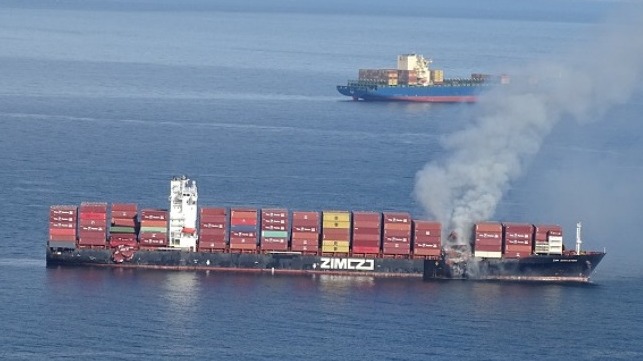TSB Report Raises Concerns Over Canada’s Response to Maritime Emergencies

The Transport Safety Board of Canada, the independent agency that looks to improve safety, issued its report on the 2021 container loss and fire on the Zim Kingston raising concerns about the country’s ability to respond to maritime emergencies. While efforts are already underway to strengthen Canada’s capabilities, the board expresses concerns about the gaps in the interim saying the environment, health, and safety are at risk when the emergency exceeds the capabilities of a vessel’s crew.
The 118-page report highlights that “fortuitous circumstances,” and the effectiveness of the crew and shipping line in its response, which included specialists that provided guidance and resources, prevented what could have been a far worse situation. The report led the board to issue two safety notices, one pointing to the cause of the incident as parametric rolling, and the second about the potential deficiencies in Canada’s preparedness.
“The occurrence involving the Zim Kingston demonstrated some of the challenges involved in responding to a marine emergency in Canadian waters. It also raised questions about the availability and capability of Canadian resources to do so,” writes the Transport Safety Board of Canada (TSB). They are calling for a “careful look at Canada’s preparedness.” In its analysts, TSB highlights this incident was contained at sea but other events might happen in port creating greater risks.
The Zim Kingston (50,782 dwt with a capacity of 4,253 TEU) was forced to wait off British Columbia due to port congestion on October 21, 2021. The report says the captain was requesting an anchorage but the vessel remained drifting about 27 nautical miles south of Ucluelet, British Columbia while experiencing a strong gale. At 10:30 p.m. local time the vessel was encountering 15-to-20-foot seas when it rolled 36 degrees from port to starboard due to what they have now determined as a parametric condition. The vessel lost approximately 11 percent of its deck cargo (109 containers).
Extensive research was conducted on the parametric condition and they found the vessel’s master and bridge were not well briefed on the phenomenon. The first safety notice focuses on improving vessel handling and crew awareness of the situation, similar to extensive efforts also underway in other parts of the industry after high-profile container losses at sea.
After the loss of the containers, the vessel was permitted to move to an anchorage. Around 36 hours later, while the vessel was anchored off Victoria, BC, a fire broke out in a damaged container that held dangerous goods (potassium amyl xanthate). The fire then spread to five nearby containers, two of which also held xanthates and three of which held tires and other consumer items. Canadian resources assisted the crew and a private response team, but the vessel was largely evacuated and the fire burned for five days before it was declared extinguished.
“The on-board fire response followed industry and company guidelines and was conducted in an efficient manner,” concludes TSB. They however note that the fire exceeded the capacity of the crew and vessel to respond, and required outside assistance. The response was deemed “efficient” and prevented the spread to larger parts of the vessel or a wider disaster.
“It also raised questions about the availability and capability of Canadian resources,” however warns the board. They point out that the Canadian Coast Guard under its mandate does not directly participate in marine fire suppression activities as part of an incident response, nor does it have fire suppression capabilities to directly respond to a vessel fire. They also highlight that Canada unlike the United States, does not require pre-arranged plans for fire response or marine salvage.
“Canada’s preparedness for other types of marine emergencies, such as occurrences involving hazardous and noxious substances (HNS) is also a concern,” warns the board. “Canada does not have a plan for how to respond to occurrences involving HNS, although it does have a plan for occurrences involving oil.”
The Canadian federal government has started an effort to improve preparedness for hazardous and noxious substances, including the development of a single national system to respond to marine pollution incidents. However, TSB notes implementation is not expected till 2027.
Transport Canada is also developing regulations to require emergency response arrangements. They anticipate this will include requirements that vessels have arrangements for firefighting and salvage services and have available specialists to work with federal and other resources in a response. However, they warn this could take four years and is not expected to be in place till 2028. TSB is calling for the efforts to be expedited as part of more urgent and effective actions to address marine emergencies in Canadian waters.
The board highlighted the long-lasting impact of these incidents using the Zim Kingston as an example. A total of 1,490 tonnes of cargo was lost overboard from the containership, yet only 48 tonnes were recovered during a short-term clean-up effort. Four containers were found on Vancouver Island a month later and 29 were located on the ocean floor. Debris washed up on the shores and even in January 2024 more debris washed ashore. They conclude that the containers lost from the Zim Kingston while likely sunk continue to release their contents into the environment.
